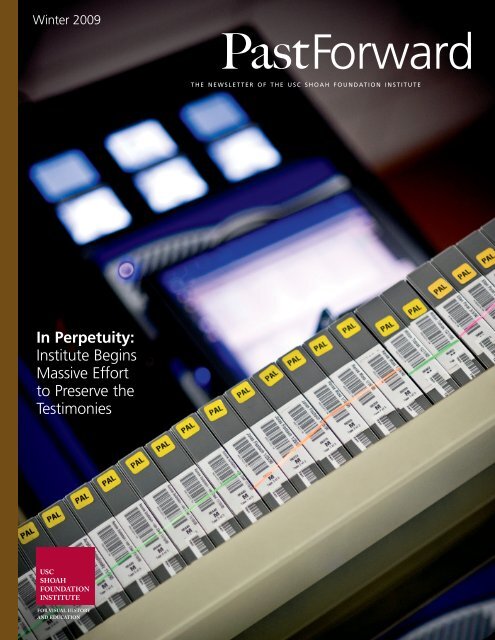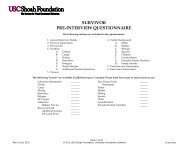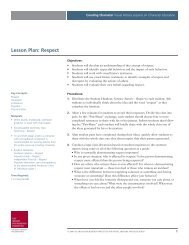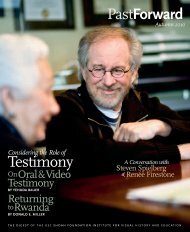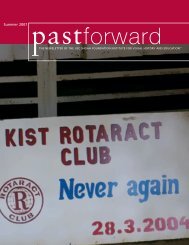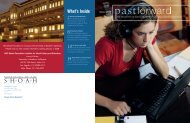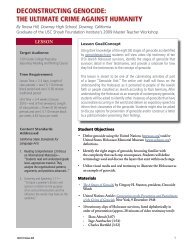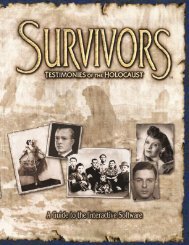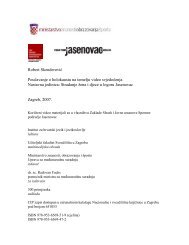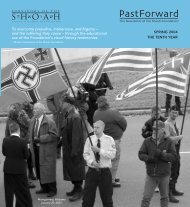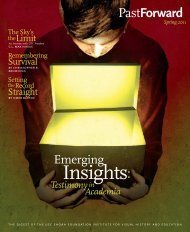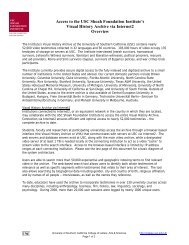Winter 2008 - USC Shoah Foundation - University of Southern ...
Winter 2008 - USC Shoah Foundation - University of Southern ...
Winter 2008 - USC Shoah Foundation - University of Southern ...
You also want an ePaper? Increase the reach of your titles
YUMPU automatically turns print PDFs into web optimized ePapers that Google loves.
<strong>Winter</strong> 2009<br />
PastForward autumn 2007<br />
PastForward<br />
THE NEWSLETTER OF THE <strong>USC</strong> SHOAH FOUNDATION INSTITUTE<br />
In Perpetuity:<br />
Institute Begins<br />
Massive Effort<br />
to Preserve the<br />
Testimonies<br />
<strong>USC</strong><br />
SHOAH<br />
FOUNDATION<br />
INSTITUTE<br />
FOR VISUAL HISTORY<br />
AND EDUCATION<br />
www.college.usc.edu/vhi C1
Board <strong>of</strong> Councilors<br />
Steven Spielberg<br />
Honorary Chair<br />
Edgar M. Bronfman<br />
Honorary Co-chair<br />
Renée Crown<br />
Honorary Co-chair<br />
Lew Wasserman<br />
Honorary Co-chair<br />
in Memoriam<br />
PastForward<br />
winter 2oo9<br />
Welcome<br />
1 2009 and Beyond<br />
Scholarship<br />
2 Testimony Offers<br />
New Possibilities for<br />
<strong>University</strong> Courses<br />
3 Visiting Scholars<br />
Explore the Archive<br />
Education<br />
4 The Legacy: New Resource<br />
for Austrian Educators<br />
New Content<br />
5 Rwandan Testimony Project<br />
Enters Planning Phase<br />
Preservation<br />
6 In Perpetuity: Institute<br />
Begins Massive Effort to<br />
Preserve the Testimonies<br />
<strong>USC</strong><br />
SHOAH<br />
FOUNDATION<br />
INSTITUTE<br />
Access to the Testimonies<br />
7 Access Across the World<br />
Scholarship<br />
7 Testimony Enhances a<br />
Range <strong>of</strong> Written Works<br />
Giving<br />
8 Ambassador for Humanity:<br />
Kirk Douglas<br />
1o Donor Highlight: Marta<br />
Kauffman and Michael Skl<strong>of</strong>f<br />
Keeping Memory Alive:<br />
Ken and Wendy Ruby<br />
Marcia Dunn and Jonathan<br />
Sobel Establish New Fund<br />
11 Extraordinary Leadership:<br />
Erna and Andrew Viterbi<br />
How You Can Make a<br />
Difference<br />
12 Partners in History and<br />
the Future<br />
On the Cover: 235,000 Beta SP tapes<br />
containing nearly 52,000 testimonies <strong>of</strong><br />
Holocaust survivors and other witnesses<br />
will be copied in an advanced digital<br />
format to ensure both preservation and<br />
access in perpetuity. See story on page 6.<br />
Wallis Annenberg<br />
Russel Bernard<br />
Gerald Breslauer<br />
Jerome Coben<br />
Stephen Cozen<br />
Susan Crown<br />
David Eisman<br />
Phyllis Epstein<br />
Emanuel Gerard<br />
Andrea Gordon<br />
Douglas Greenberg<br />
Eric Greenberg<br />
Yossie Hollander<br />
Robert Katz<br />
William Lauder<br />
Lee Liberman<br />
Skip Paul<br />
Bruce Ramer<br />
Harry Robinson<br />
Michael Rutman<br />
Mickey Shapiro<br />
Erna Viterbi<br />
Casey Wasserman<br />
Harold Williams<br />
Founding Executive Directors<br />
June Beallor<br />
James Moll<br />
Founding Advisory Committee<br />
Karen Kushell<br />
Branko Lustig<br />
Gerald R. Molen<br />
Executive Staff<br />
Kim Simon<br />
Interim Executive Director,<br />
Director <strong>of</strong> Programs<br />
Sam Gustman,<br />
Chief Technology Officer<br />
Karen Jungblut,<br />
Director <strong>of</strong> Research<br />
and Documentation<br />
Steven Klappholz,<br />
Executive Director <strong>of</strong> Development<br />
Ari Zev<br />
Director <strong>of</strong> Administration<br />
FOR VISUAL<br />
HISTORY AND<br />
EDUCATION
Welcome<br />
PastForward winter 2009<br />
2oo9 and Beyond<br />
this year, as a result<br />
<strong>of</strong> the completion<br />
<strong>of</strong> a new strategic<br />
plan, the Institute<br />
has begun putting into action a<br />
series <strong>of</strong> global initiatives. They<br />
will give us greater leverage<br />
to advance scholarship<br />
and research, support testimony-based<br />
education,<br />
broaden access to the<br />
archive, preserve the<br />
testimonies, and acquire<br />
new archival content. At<br />
the same time that we<br />
have refocused our work<br />
around these initiatives,<br />
we have bid farewell to<br />
our Executive Director,<br />
Douglas Greenberg, who<br />
has become Executive Dean <strong>of</strong><br />
the School <strong>of</strong> Arts and Sciences<br />
at Rutgers <strong>University</strong>, his alma<br />
mater.<br />
The Institute’s work will<br />
always bear the stamp <strong>of</strong> Doug’s<br />
leadership. When he began his<br />
tenure eight years ago as President<br />
and Chief Executive<br />
Officer <strong>of</strong> the <strong>Shoah</strong> <strong>Foundation</strong>,<br />
his vision extended far<br />
beyond its double-wide trailers<br />
on the back lot at Universal<br />
Studios. Under his guidance,<br />
the <strong>Foundation</strong> adopted a new<br />
mission and a practical education<br />
plan, and pr<strong>of</strong>oundly refined<br />
the methodology for cataloging<br />
and indexing the testimonies.<br />
We are very grateful for Doug’s<br />
passionate commitment to the<br />
organization, which led to so<br />
many accomplishments and—<br />
most importantly—led us to<br />
become part <strong>of</strong> the <strong>University</strong><br />
<strong>of</strong> <strong>Southern</strong> California. Working<br />
with board members, donors,<br />
volunteers, and staff, Doug<br />
helped to lay the groundwork<br />
that is enabling the Institute<br />
to begin its next stage <strong>of</strong><br />
activity.<br />
Thanks to advancements in<br />
telecommunications, the rapid<br />
evolution <strong>of</strong> digital video technology,<br />
and our full integration<br />
into a leading university, there<br />
has never been greater opportunity<br />
to share the testimonies<br />
"Thanks to advancements in telecommunication,<br />
the rapid evolution <strong>of</strong> digital video technology,<br />
and our full integration into a leading university,<br />
there has never been greater opportunity to<br />
share the testimonies with the world.”<br />
— Kim Simon<br />
with the world, and the Institute<br />
is taking advantage <strong>of</strong> this<br />
opportunity through the global<br />
initiatives now being implemented.<br />
Though they will<br />
transform the way we pursue<br />
our mission, the initiatives are<br />
a continuation <strong>of</strong> nearly 15<br />
years <strong>of</strong> work; what began in<br />
1994 as Steven Spielberg’s<br />
vision—an effort to change<br />
the world through the preservation<br />
and educational use <strong>of</strong><br />
Holocaust survivors’ and other<br />
witnesses’ memories—will<br />
continue in 2009 and beyond.<br />
The following pages <strong>of</strong>fer<br />
insight into some <strong>of</strong> the ways<br />
the Institute’s global initiatives<br />
are being put into practice. You<br />
will read about new opportunities<br />
being created through support<br />
from numerous donors,<br />
including a generous endowment<br />
from the Viterbi Family<br />
<strong>Foundation</strong> <strong>of</strong> the Jewish Community<br />
<strong>Foundation</strong>, which will<br />
make it possible for the Institute<br />
to reach students, educators,<br />
scholars, researchers, and<br />
the general public through an<br />
enhanced website. You will learn<br />
about an effort funded by the<br />
<strong>USC</strong> Office <strong>of</strong> the Provost to<br />
preserve the testimonies in a<br />
digital format that will ensure<br />
their preservation and facilitate<br />
access, as well as about the<br />
release <strong>of</strong> the first testimonybased<br />
resource for educators<br />
in Austria. These pages will<br />
also shed light on the progress<br />
IBUKA, our partner in Rwanda,<br />
has made as the Rwandan testimony<br />
project enters the planning<br />
phase.<br />
The name PastForward<br />
implies a recognition and understanding<br />
<strong>of</strong> the importance <strong>of</strong><br />
the testimonies <strong>of</strong> Holocaust<br />
survivors and other witnesses in<br />
recording the past and sharing<br />
critical messages for the future.<br />
It also implies a continuum<br />
<strong>of</strong> activity that began with the<br />
establishment <strong>of</strong> the <strong>Shoah</strong><br />
<strong>Foundation</strong> and is being<br />
carried on by the <strong>USC</strong> <strong>Shoah</strong><br />
<strong>Foundation</strong> Institute. Thank<br />
you for your continued support.<br />
Kim Simon<br />
Interim Executive Director<br />
www.college.usc.edu/vhi 1
Scholarship<br />
Testimony Offers<br />
New Possibilities for<br />
<strong>University</strong> Courses<br />
(Clockwise from above)<br />
Dr. Macarena Gómez-Barris,<br />
Associate Pr<strong>of</strong>essor <strong>of</strong> Sociology;<br />
Dr. Vanessa Schwartz, Pr<strong>of</strong>essor<br />
<strong>of</strong> History; Dr. Colin Keaveny,<br />
Lecturer, Department <strong>of</strong> French<br />
and Italian.<br />
this fall, students<br />
at <strong>USC</strong> were introduced<br />
to testimony<br />
from the Institute’s<br />
archive in an academic course<br />
on urban life in Europe, in a<br />
course that explored a French<br />
memoir about a Jewish girl<br />
deported to Auschwitz during<br />
World War II, and in a course<br />
on the sociology <strong>of</strong> memory.<br />
“The archive is rich with<br />
testimony about many things,<br />
not just life in the concentration<br />
camps,” said Dr. Vanessa<br />
Schwartz, Pr<strong>of</strong>essor <strong>of</strong> History.<br />
This fall, Schwartz taught a<br />
course called “Street Life:<br />
Urban Culture in Modern<br />
Europe,” which included a<br />
new unit featuring testimony<br />
describing urban life under<br />
occupation. Schwartz is now<br />
using the archive to prepare for<br />
an upcoming course on the history<br />
<strong>of</strong> modern France, which<br />
will use testimony to explore<br />
events such as the Rafle du<br />
Vélodrome d’Hiver, a 1942 raid<br />
involving French authorities,<br />
which was orchestrated to<br />
reduce the Jewish population<br />
<strong>of</strong> Paris.<br />
In the department <strong>of</strong> French<br />
and Italian, lecturer Dr. Colin<br />
Keaveny teaches an introduction<br />
to French literature course.<br />
This fall, he used testimony to<br />
“illustrate, amplify, and frame<br />
issues and historical events”<br />
described in Dora Bruder,<br />
French novelist Patrick<br />
Modiano’s memoir <strong>of</strong> a 15-<br />
year-old Jewish girl who was<br />
deported from France to<br />
Auschwitz in 1942. “In cases<br />
where people, places, and<br />
events mentioned in the book<br />
were also mentioned in testimony,”<br />
Keaveny explained, “the<br />
testimony was used<br />
to continue the work<br />
<strong>of</strong> the book by further<br />
excavating forgotten<br />
or neglected<br />
histories.” Students<br />
also used testimony<br />
to enhance presentations<br />
about aspects<br />
<strong>of</strong> life under German<br />
occupation. “The<br />
testimonies hold so<br />
much unexpected<br />
information,” he said.<br />
“For example, one<br />
survivor, who was<br />
remembering<br />
internment in<br />
a Paris camp,<br />
ended up<br />
talking about<br />
young love,<br />
which is<br />
something<br />
any student<br />
can relate to.”<br />
Associate<br />
Pr<strong>of</strong>essor <strong>of</strong><br />
Sociology<br />
Dr. Macarena<br />
Gómez-Barris used testimony as<br />
part <strong>of</strong> a graduate course called<br />
“Sociology <strong>of</strong> Memory.” The<br />
course, which was designed to<br />
give students “theoretical, conceptual,<br />
and analytical skills in<br />
memory studies,” gave particular<br />
focus to how society deals<br />
with long-term effects and<br />
traces <strong>of</strong> genocide, state-sponsored<br />
terror, and other forms<br />
2 usc shoah foundation institute for visual history and education
PastForward winter 2009<br />
<strong>of</strong> violence. This fall, Gómez-<br />
Barris expanded the course to<br />
include a segment in which students<br />
worked directly with<br />
Holocaust testimony. “It is<br />
through visual and archival<br />
witness <strong>of</strong> the enormity <strong>of</strong> such<br />
events as the Holocaust that<br />
one can truly contemplate its<br />
effects,” she said.<br />
The courses taught by<br />
Schwartz, Keaveny, and Gómez-<br />
Barris are just three <strong>of</strong> the 80<br />
university courses that have<br />
been enhanced by testimony<br />
from the archive.<br />
SCHOLARSHIP<br />
Visiting Scholars<br />
Explore the Archive<br />
dr. Jacek Leociak,<br />
Assistant Pr<strong>of</strong>essor<br />
in the Institute <strong>of</strong><br />
Literary Research<br />
at the Polish Academy <strong>of</strong><br />
Sciences, and co-founder <strong>of</strong><br />
the Polish Center for Holocaust<br />
Studies, is writing a book on<br />
the rescue <strong>of</strong> Jews in Poland<br />
during World War II. In August,<br />
he visited the Institute to conduct<br />
research in the archive.<br />
“Though I have studied<br />
written sources for many years,<br />
I was never able to work with<br />
audiovisual accounts <strong>of</strong> rescue<br />
before coming to the Institute,”<br />
Leociak said. “The archive has<br />
made a significant contribution<br />
to my research.”<br />
Leociak is one <strong>of</strong> eleven<br />
doctoral candidates and senior<br />
scholars who visited the Institute<br />
between 2007 and <strong>2008</strong><br />
as recipients <strong>of</strong> the Corrie<br />
ten Boom Research Award.<br />
Established in memory <strong>of</strong> the<br />
renowned Dutch rescuer <strong>of</strong><br />
Jews during World War II and<br />
made possible through generous<br />
funding by the Ahmanson<br />
Charitable Community Trust,<br />
the awards enabled scholars<br />
to visit the Institute for one<br />
to two months. While at the<br />
Institute, they received training<br />
in the use <strong>of</strong> its digital<br />
library s<strong>of</strong>tware, access to the<br />
archive, and an opportunity to<br />
present their findings to audiences<br />
at <strong>USC</strong>.<br />
In addition to Leociak, two<br />
other Corrie ten Boom Research<br />
Award recipients, Russell Spinney<br />
and Andree Michaelis, visited<br />
the Institute in recent months.<br />
Spinney, a doctoral student in<br />
Pennsylvania State <strong>University</strong>’s<br />
history department, used the<br />
archive to support his dissertation<br />
on the German communities<br />
<strong>of</strong> Nuremberg, Erfurt, and<br />
Magdeburg in the aftermath <strong>of</strong><br />
World War I. “The testimonies<br />
provided rich detail about how<br />
these communities were changing<br />
and how people responded<br />
to those changes,” Spinney<br />
explained. “I uncovered stories<br />
<strong>of</strong> how people survived; stories<br />
<strong>of</strong> fear, perseverance, persecution;<br />
stories <strong>of</strong> rescue; stories <strong>of</strong><br />
revenge. The hundreds <strong>of</strong> trajectories<br />
<strong>of</strong> individual lives<br />
helped put things in perspective<br />
in very human terms.”<br />
Speaking about the theme <strong>of</strong><br />
rescue during his presentation,<br />
Spinney said, “Corrie ten Boom<br />
was the first Dutch woman to<br />
be licensed as a watchmaker<br />
in the Netherlands…but she is<br />
by far more remembered for<br />
her efforts to help rescue and<br />
aid the survival <strong>of</strong> Jews fleeing<br />
the Nazi regime. Rescue and<br />
survival are themes <strong>of</strong> great<br />
importance... [And] I want to<br />
further cast our search for the<br />
stories <strong>of</strong> rescue and survival<br />
back before the Nazi seizure<br />
<strong>of</strong> power in 1933.”<br />
“I uncovered stories <strong>of</strong> how people survived;<br />
stories <strong>of</strong> fear, perseverance, persecution; stories<br />
<strong>of</strong> rescue; stories <strong>of</strong> revenge. The hundreds <strong>of</strong><br />
trajectories <strong>of</strong> individual lives helped put things<br />
in perspective in very human terms.”<br />
— Russell Spinney<br />
Andree Michaelis is a doctoral<br />
student in the Friedrich<br />
Schlegel School <strong>of</strong> Literary<br />
Studies at Freie Universität<br />
Berlin. He visited the Institute<br />
to conduct research on how<br />
survivors use the interview as<br />
a discursive space to recount<br />
their life histories. “I wanted<br />
to watch testimony through<br />
the eyes <strong>of</strong> a literary scholar,<br />
regarding the interviewees as<br />
authors,” he said. “There is a<br />
need—‘obligation’ might be<br />
the right word—to work with<br />
the archive.”<br />
To view video <strong>of</strong> recent presentations<br />
and interviews with<br />
Corrie ten Boom Research<br />
Award recipients, visit www.<br />
college.usc.edu/ vhi/ news/<br />
corrietenboom_interviews.<br />
To learn how you can<br />
support this effort, visit www.<br />
college.usc.edu/vhi/donate.<br />
Russell Spinney, a doctoral student from Penn State <strong>University</strong>, shows<br />
audience members the geographic locations <strong>of</strong> the communities he<br />
studied using testimony from the archive.<br />
www.college.usc.edu/vhi 3
Education<br />
The Legacy: New Resource<br />
for Austrian Educators<br />
Affairs and Department for<br />
Political Education).<br />
Dr. Markus Barnay, who<br />
co-managed the development<br />
<strong>of</strong> The Legacy, said, “As time<br />
passes, it will become increasingly<br />
difficult for students to<br />
conceive <strong>of</strong> the Holocaust as<br />
more than a vague historical<br />
event with little bearing on<br />
their everyday lives. But<br />
through their testimonies, the<br />
survivors whose stories are<br />
featured in The<br />
Legacy will help<br />
students grasp<br />
the reality <strong>of</strong> the<br />
Holocaust as a<br />
Camps; Mass Murder; and<br />
Life in Austria after 1945.<br />
“We wanted The Legacy to<br />
be able to do more than help<br />
educators teach history,” Dreier<br />
said. “We wanted to craft a<br />
resource that will engage students<br />
on a deep emotional<br />
level, as well as intellectually,<br />
and we think we have accomplished<br />
this in The Legacy; but it<br />
would not have been possible<br />
without the contribution <strong>of</strong> the<br />
survivors whose testimonies<br />
bring the past to life.”<br />
The Legacy’s teaching modules<br />
include ready-to-use classroom<br />
activities, and separate versions<br />
“The survivors whose stories are featured<br />
in The Legacy will help students grasp the<br />
reality <strong>of</strong> the Holocaust as a consequence<br />
<strong>of</strong> intolerance, and this understanding<br />
may help them make right decisions<br />
when faced with moral dilemmas.”<br />
— Dr. Markus Barnay<br />
From left: Barbara Prammer,<br />
President <strong>of</strong> the Austrian National<br />
Council, and survivors Dr. Helga<br />
Feldner-Busztin, Sophie Haber, and<br />
Elisabeth Scheiderbauer.<br />
in May, Barbara Prammer,<br />
President <strong>of</strong> the Austrian<br />
National Council, and<br />
Claudia Schmied, Federal<br />
Minister for Education, Arts<br />
and Culture, hosted an event at<br />
the Abgeordnetensprechzimmer<br />
(the parlor <strong>of</strong> the Austrian parliament)<br />
to mark the release <strong>of</strong><br />
Das Vermächtnis (The Legacy).<br />
Developed by erinnern.at,<br />
The Legacy is the first Austrian<br />
educational resource based on<br />
testimony from the archive.<br />
Erinnern.at, founded and<br />
directed by Dr. Werner Dreier<br />
and Mag. Peter Niedermair, is a<br />
teacher-education organization<br />
<strong>of</strong> the Austrian Federal Ministry<br />
for Education, Arts and Culture<br />
(Department for Bilateral<br />
consequence <strong>of</strong> intolerance,<br />
and this understanding may<br />
help them make right decisions<br />
when faced with moral<br />
dilemmas.”<br />
The Legacy is a two-DVD multimedia<br />
resource that centers on<br />
91 video clips from the testimonies<br />
<strong>of</strong> 13 Holocaust survivors.<br />
Their memories enhance<br />
eight teaching modules that<br />
cover topics related to the history<br />
<strong>of</strong> the Holocaust in Austria.<br />
Topics include Childhood and<br />
Youth before 1938; Flight and<br />
Expulsion; Concentration<br />
<strong>of</strong> each module are provided<br />
for teachers <strong>of</strong> students ages<br />
10–14 (junior grade) and students<br />
ages 15–18 (senior grade).<br />
“The Legacy’s use <strong>of</strong> testimony<br />
as a core primary source brings<br />
innovation and the potential to<br />
enrich traditional teaching and<br />
learning in the classroom,” said<br />
Kim Simon, Institute Interim<br />
Executive Director. “When<br />
combined with other primary<br />
sources, as well as information<br />
and mediation, a proper context<br />
emerges, and the opportunity<br />
for learning—and for connecting<br />
to the value <strong>of</strong> what has<br />
been said and seen—increases.”<br />
To learn how you can support<br />
the Institute’s international<br />
educational outreach, visit<br />
www.college.usc.edu/vhi/donate.<br />
4 usc shoah foundation institute for visual history and education
New Conent<br />
PastForward winter 2009<br />
Rwandan Testimony Project<br />
Enters Planning Phase<br />
Emmanuel Gatali (second from<br />
right), a survivor from Rwamagana<br />
in Kibungo Province, gives the first<br />
interview <strong>of</strong> the GTR IBUKA project<br />
at Nyanza-Kicukiro, the site <strong>of</strong> the<br />
massacre he survived.<br />
“<br />
the vision <strong>of</strong> the<br />
<strong>Shoah</strong> <strong>Foundation</strong><br />
[Institute] is very<br />
similar to the vision<br />
<strong>of</strong> IBUKA, with respect to the<br />
victims, respect <strong>of</strong> the memory,”<br />
said François Ngarambe <strong>of</strong><br />
IBUKA, the umbrella organization<br />
representing survivors <strong>of</strong><br />
the 1994 Rwandan Tutsi genocide.<br />
“I am committed to fight<br />
so that genocide never happens<br />
again, and my weapon is to preserve<br />
memory.”<br />
Ngarambe is heading a joint<br />
project <strong>of</strong> the Institute and<br />
IBUKA, which aims to collect<br />
testimony from Rwandan survivors.<br />
“IBUKA has made real<br />
progress since partnering with<br />
the Institute last November,”<br />
Karen Jungblut, Institute<br />
Director <strong>of</strong> Research and<br />
Documentation, said after visiting<br />
Rwanda in May. She cited<br />
such milestones as the allocation<br />
and preparation <strong>of</strong> a building<br />
where future interviews<br />
may take place, as well as the<br />
completion <strong>of</strong> pilot interviews<br />
with survivors.<br />
The first interview occurred<br />
at Nyanza-Kicukiro, a hill outside<br />
Kigali, Rwanda’s capital.<br />
While videographer Christian<br />
Gakombe ran his camera,<br />
Emmanuel Gatali stood on the<br />
very site <strong>of</strong> the massacre he<br />
survived and described what<br />
he witnessed there to interviewer<br />
Emmanuel Gasana.<br />
Later that day, IBUKA interviewed<br />
a second survivor,<br />
Evelyn Bankundiye, and the<br />
following day, survivor Venuste<br />
Karasira gave his testimony.<br />
“We plan to collect testimony<br />
from thousands <strong>of</strong> survivors,<br />
so interviews like these are an<br />
important step in understanding<br />
what is needed for a pilot<br />
phase <strong>of</strong> testimony collection,”<br />
said Theodore Simburudali,<br />
IBUKA President.<br />
Kamuronsi and Freddy<br />
Mutanguha to adapt the PIQ<br />
from a version developed by the<br />
Institute for use with Holocaust<br />
survivors and other witnesses.<br />
She also joined Simburudali and<br />
Ngarambe for a meeting with<br />
Joseph Habineza, Minister <strong>of</strong><br />
Sports and Culture, who<br />
expressed his support—and that<br />
<strong>of</strong> the Rwandan government—<br />
after being briefed on the<br />
Institute and its partnership<br />
with IBUKA.<br />
“The enthusiasm with which<br />
our colleagues in Rwanda have<br />
undertaken this project reveals<br />
how important it is to them that<br />
survivors be given a chance to<br />
share their stories with the world,”<br />
Jungblut said. “The Institute is<br />
grateful for the opportunity to<br />
assist IBUKA, as it endeavors to<br />
preserve memories <strong>of</strong> the<br />
Rwandan Tutsi genocide.”<br />
IBUKA and the Institute<br />
are now raising funds to be<br />
able to begin a pilot project.<br />
Once IBUKA has collected the<br />
Rwandan testimonies, they will<br />
become part <strong>of</strong> the Institute’s<br />
Visual History Archive. “From<br />
“I am committed to fight so that genocide<br />
never happens again, and my weapon is<br />
to preserve memory.” — François Ngarambe<br />
The project team<br />
completed another<br />
important step when<br />
it drafted the preinterview<br />
questionnaire<br />
(PIQ) survivors<br />
will complete before<br />
giving testimony.<br />
“Interviewers will be<br />
able to think <strong>of</strong> specific<br />
questions to ask<br />
based on survivors’<br />
responses to the PIQ,”<br />
explained Jungblut,<br />
who worked with colleagues<br />
Yves<br />
this testimony, the children <strong>of</strong><br />
Rwanda…will understand exactly<br />
what happened to their families,<br />
their parents, their sisters<br />
and their brothers,” Mutanguha<br />
said, “and not [only] the children<br />
<strong>of</strong> Rwanda but also the<br />
children <strong>of</strong> the world.”<br />
To view video interviews<br />
in which Rwandan colleagues<br />
discuss the project and recall<br />
their memories <strong>of</strong> the 1994<br />
genocide, visit www.college.<br />
usc.edu/vhi/ pr/Rwanda.<br />
www.college.usc.edu/vhi 5
Preservation<br />
In Perpetuity: Institute<br />
Begins Massive Effort to<br />
Preserve the Testimonies<br />
before.’ But from every story,<br />
you learn a little bit.”<br />
To make certain that there<br />
will be future opportunities to<br />
learn from these stories, the<br />
Institute, with funding from<br />
the <strong>USC</strong> Office <strong>of</strong> the Provost,<br />
began a massive, multiyear initiative<br />
to copy all <strong>of</strong> the nearly<br />
52,000 testimonies in its<br />
archive in an advanced digital<br />
format, which will ensure their<br />
preservation and help to make<br />
“But all tape deteriorates<br />
over time, and these master<br />
copies will eventually become<br />
unusable, which is why the<br />
Institute must act now to<br />
prevent the loss <strong>of</strong> the testimonies.”<br />
Over the next several years,<br />
the Institute will store the testimonies<br />
in a format called<br />
Motion JPEG (MJPEG) 2000.<br />
“This is becoming the format<br />
<strong>of</strong> choice used to store moving<br />
images,” Gustman said, “and<br />
the Institute is one <strong>of</strong> the<br />
largest early adopters <strong>of</strong> this<br />
technology.”<br />
In May, the first 15,000 <strong>of</strong> a<br />
total <strong>of</strong> 235,000 videotapes<br />
“All tape deteriorates<br />
over time, and these<br />
master copies will<br />
eventually become<br />
unusable, which is<br />
why the Institute<br />
must act now to<br />
prevent the loss <strong>of</strong><br />
the testimonies.”<br />
— Sam Gustman<br />
From left: Sam Gustman, Institute<br />
Chief Technology Officer, and<br />
<strong>USC</strong> students Ribhu Shekhar and<br />
Badrish Patil help transport<br />
videotapes that hold master<br />
recordings <strong>of</strong> interviews with<br />
Holocaust survivors and other<br />
witnesses. The testimonies are<br />
stored on 235,000 videotapes, all<br />
<strong>of</strong> which will be duplicated as<br />
digital files identical in quality to<br />
the original recordings.<br />
“t<br />
his is in perpetuity,”<br />
Holocaust<br />
survivor Isaac<br />
Goodfriend said<br />
when he shared his testimony<br />
with the <strong>Shoah</strong> <strong>Foundation</strong> in<br />
1996. “This is something that<br />
will be perpetuated in the<br />
libraries <strong>of</strong> the world, and<br />
there will be an exchange;<br />
because every survivor has a<br />
story to tell. And it is not repetitious.<br />
Some people think,<br />
‘Well, I have heard this story<br />
them accessible to a worldwide<br />
audience.<br />
“The testimonies were originally<br />
recorded to videotape,”<br />
said Sam Gustman, Institute<br />
Chief Technology Officer.<br />
made a cross-country journey<br />
from a vault in the eastern<br />
United States to the Institute.<br />
Upon arrival, two MJPEG<br />
2000 copies <strong>of</strong> each testimony<br />
6 usc shoah foundation institute for visual history and education
PastForward winter 2009<br />
are created. In addition to<br />
these replicas—which are<br />
stored on servers at a <strong>USC</strong> data<br />
center—copies <strong>of</strong> each testimony<br />
are generated in various<br />
formats suited for playback on<br />
all types <strong>of</strong> commercial video<br />
players. These formats include<br />
downloadable MPEGs, Flash<br />
files that can be streamed over<br />
ACCESS TO THE TESTIMONIES<br />
Access Across the World<br />
Collections <strong>of</strong> testimony are<br />
publicly accessible at more than<br />
100 locations in 23 countries.<br />
Recently, collections were established<br />
at the following sites:<br />
• Center for the Activation<br />
<strong>of</strong> the Young in Krakow,<br />
Poland<br />
• Facing History and<br />
Ourselves in Brookline,<br />
Massachusetts<br />
• KZ-Gedenkstätteninitiative<br />
Leonberg e.V. in Leonberg,<br />
Germany<br />
• Les "Oublié(e)s" de la<br />
Mémoire in Livry Gargan,<br />
France<br />
the internet, as well as<br />
Windows Media Player files<br />
and QuickTime files.<br />
The preservation project<br />
will also pave the way for the<br />
archive to be stored on servers<br />
at multiple research institutions,<br />
which will enable more<br />
people to access the archive<br />
than ever before. “<strong>USC</strong> has<br />
All <strong>of</strong> the nearly 52,000 testimonies<br />
in the archive are available<br />
at the following 17<br />
institutions in Australia,<br />
Germany, Israel, and the United<br />
States:<br />
• Brown <strong>University</strong><br />
in Providence, Rhode Island<br />
• Columbia <strong>University</strong><br />
in New York, New York<br />
• Duke <strong>University</strong><br />
in Durham, North Carolina<br />
• Florida Atlantic <strong>University</strong><br />
in Boca Raton, Florida<br />
• Freie Universität Berlin<br />
in Berlin, Germany<br />
pledged to preserve and provide<br />
access to the testimonies,<br />
and this initiative serves both<br />
purposes,” Gustman said.<br />
For more information about<br />
the project, including quick<br />
facts, a Podcast, and a radio<br />
interview with Sam Gustman,<br />
visit www.college.usc.edu/vhi/<br />
preservation.<br />
• Monash <strong>University</strong><br />
in Melbourne, Australia<br />
• North Carolina State<br />
<strong>University</strong> in Raleigh,<br />
North Carolina<br />
• Rice <strong>University</strong><br />
in Houston, Texas<br />
• Syracuse <strong>University</strong><br />
in Syracuse, New York<br />
• <strong>University</strong> <strong>of</strong> California, San<br />
Diego in San Diego, California<br />
• <strong>University</strong> <strong>of</strong> Michigan<br />
in Ann Arbor, Michigan<br />
• <strong>University</strong> <strong>of</strong> Minnesota<br />
in Minneapolis, Minnesota<br />
• <strong>University</strong> <strong>of</strong> North<br />
Carolina at Chapel Hill,<br />
in Chapel Hill, North Carolina<br />
• <strong>University</strong> <strong>of</strong> South Florida<br />
in Tampa, Florida<br />
• <strong>University</strong> <strong>of</strong> <strong>Southern</strong><br />
California in Los Angeles,<br />
California<br />
• United States Holocaust<br />
Memorial Museum<br />
in Washington, D.C.<br />
• Yad Vashem in Jerusalem,<br />
Israel<br />
The Institute continues to connect<br />
new institutions to the<br />
archive. For an interactive map<br />
<strong>of</strong> sites that <strong>of</strong>fer access to all<br />
the testimonies and sites that<br />
<strong>of</strong>fer access to testimony collections,<br />
visit www.college.usc.<br />
edu/vhi/testimoniesaroundtheworld.<br />
To find out how to support<br />
access to the testimonies,<br />
visit www.college.usc.edu/vhi/<br />
donate.<br />
SCHOLARSHIP<br />
Testimony Enhances a<br />
Range <strong>of</strong> Written Works<br />
Authors have used the testimonies in<br />
the archive as source material for<br />
written works on a wide variety <strong>of</strong><br />
subjects. Some <strong>of</strong> the many publications<br />
are highlighted below.<br />
Kerry Bluglass<br />
Hidden from the Holocaust: Stories<br />
<strong>of</strong> Resilient Children Who Survived<br />
and Thrived (2003)<br />
Christopher Browning<br />
Collected Memories: Holocaust<br />
History and Postwar Testimony (2003)<br />
Beth B. Cohen<br />
Case Closed: Holocaust Survivors in<br />
Postwar America (2007)<br />
Svetlana Danilova<br />
Exodus <strong>of</strong> the Mountain Jews:<br />
Destruction <strong>of</strong> the Harmony <strong>of</strong> the<br />
Worlds (2000)<br />
Paula J. Draper<br />
Canadian Holocaust Survivors: From<br />
Liberation to Rebirth (1996–1997)<br />
Jonathan Friedman<br />
Speaking the Unspeakable: Essays on<br />
Sexuality, Gender and Holocaust<br />
Survivor Memory (2003)<br />
David Guttmann and Zev Harel<br />
Holocaust Survivors and the State <strong>of</strong><br />
Israel (<strong>2008</strong>)<br />
Kenneth I. Helphand<br />
Defiant Gardens: Making Gardens in<br />
Wartime (2006)<br />
Jeff Hill<br />
Primary Source Series: The Holocaust<br />
(2006)<br />
Sheila Isenberg<br />
A Hero <strong>of</strong> Our Own: The Story <strong>of</strong><br />
Varian Fry (2001)<br />
Peter W. Klein and Justus van de<br />
Kamp<br />
Het Philips-Kommando in Kamp<br />
Vught (2003)<br />
Ladislaus Löb<br />
Dealing with Satan: Rezso Kasztner's<br />
Daring Rescue Mission (<strong>2008</strong>)<br />
Ilana Rosen<br />
In Auschwitz We Blew the Sh<strong>of</strong>ar:<br />
Carpatho-Russian Jews Remember<br />
the Holocaust (2004)<br />
Therkel Straede<br />
The Volkswagen Jews: Jewish Slave<br />
Labour in Nazi Germany Armaments<br />
Industry (1998–1999)<br />
www.college.usc.edu/vhi 7
Giving<br />
Ambassador for Humanity:<br />
Kirk Douglas<br />
in October, the <strong>USC</strong><br />
<strong>Shoah</strong> <strong>Foundation</strong><br />
Institute and Steven<br />
Spielberg honored legendary<br />
actor and humanitarian<br />
Kirk Douglas with the<br />
Ambassadors for Humanity<br />
Award at its annual gala event.<br />
Douglas was honored for a lifetime<br />
<strong>of</strong> humanitarian service,<br />
social activism, and philanthropy<br />
that has touched lives<br />
throughout the world.<br />
More than 500 guests attended<br />
the gala event, which was<br />
hosted by Billy Crystal and featured<br />
a special performance by<br />
Bette Midler.<br />
To view video from the<br />
event, visit www.college.usc.<br />
edu/vhi/pr/AFH_October<strong>2008</strong>/<br />
event_video.php.<br />
1<br />
2<br />
1 From left: Jerry and Natalie<br />
Nankin, Anita Hirsch, Rhoda<br />
Howard, and Robert Hirsch.<br />
2 From left: Billy Crystal, Kirk<br />
Douglas, Steven Spielberg, Wallis<br />
Annenberg, and Steven B. Sample.<br />
3<br />
3 From left: Cydney and Bill<br />
Osterman, Helene Galen.<br />
4 From left: Erna Viterbi,<br />
Stephen Cozen, Kim Simon,<br />
Mickey Shapiro.<br />
5 From left: Bobbi and Marvin<br />
Holland, Gloria Lushing.<br />
5<br />
4<br />
8 usc shoah foundation institute for visual history and education
PastForward winter 2009<br />
6<br />
7<br />
8<br />
“Horace Mann said,<br />
‘Be ashamed to die<br />
before making a victory<br />
for humanity.’ …<br />
I am proud to be here<br />
this evening, and I<br />
want you to know<br />
that I think the <strong>Shoah</strong><br />
<strong>Foundation</strong> [Institute]<br />
has inspired all <strong>of</strong> us to<br />
become ambassadors<br />
for humanity.”<br />
—Kirk Douglas,<br />
Ambassadors for<br />
Humanity Award<br />
honoree<br />
6 Steven B. Sample and<br />
Bruce Ramer.<br />
7 From left: Ronald and Judy<br />
Mack, Dawn and Steve Mack.<br />
8 From left: Robert Katz, Howard<br />
Gillman, Mickey Shapiro, Phyllis<br />
Epstein, Erna Viterbi, Steven<br />
Spielberg, Bruce Ramer, Stephen<br />
Cozen, Kim Simon, Michael<br />
Rutman, and Yossie Hollander.<br />
9 Steven Spielberg and<br />
Kirk Douglas.<br />
10 Phil and Monica Rosenthal.<br />
11 Bette Midler.<br />
12<br />
9<br />
12 Tammy Chase Wright<br />
and Michael Kent.<br />
11 10<br />
www.college.usc.edu/vhi 9
Giving<br />
New Funds to<br />
Pursue Mission<br />
Michael Skl<strong>of</strong>f and Marta Kauffman<br />
Ken and Wendy Ruby<br />
Jonathan Sobel and Marcia Dunn<br />
Donor Highlight:<br />
Marta Kauffman<br />
and Michael Skl<strong>of</strong>f<br />
“One <strong>of</strong> the greatest legacies<br />
we could ever hope to leave<br />
our children is a world free from<br />
prejudice, intolerance, and bigotry,”<br />
Marta Kauffman said.<br />
“The educational use <strong>of</strong> the<br />
testimonies can help us achieve<br />
such a legacy by inspiring<br />
young people to embrace diversity,<br />
encouraging them to disregard<br />
stereotypes, and teaching<br />
them to recognize the value <strong>of</strong><br />
every individual.”<br />
Kauffman and her husband,<br />
Michael Skl<strong>of</strong>f, have stood with<br />
the Institute for more than a<br />
decade. They have provided<br />
funding for the Ambassadors<br />
for Humanity events and established<br />
the Marta Kauffman and<br />
Michael Skl<strong>of</strong>f Education and<br />
Program Fund, which has<br />
enabled the Institute to reach<br />
out to educators and students<br />
in the United States, support<br />
scholarship and research, broaden<br />
access to the archive, and<br />
increase educational programming<br />
worldwide.<br />
“When Marta and I first<br />
learned about the Institute and<br />
its educational mission, we<br />
knew we had to get involved,”<br />
said Skl<strong>of</strong>f. “None <strong>of</strong> the books,<br />
photographs, or films that<br />
depict the Holocaust have adequately<br />
captured or conveyed<br />
its devastating reality. But it was<br />
captured in the memories <strong>of</strong><br />
survivors and other witnesses,<br />
and their memories are preserved<br />
as testimony that can be<br />
shared with the world.”<br />
“It is important to preserve the<br />
memories <strong>of</strong> survivors <strong>of</strong> other<br />
genocides as well,” Kauffman<br />
added, “which is why we were<br />
so impressed to learn that the<br />
Institute will expand the archive,<br />
beginning first by including<br />
interviews with survivors <strong>of</strong> the<br />
Rwandan genocide.”<br />
In addition to their support<br />
<strong>of</strong> the Institute, Kauffman and<br />
Skl<strong>of</strong>f are active in many community<br />
organizations, including<br />
the Los Angeles Free Clinic,<br />
Children’s Alliance, the Martin<br />
Luther King, Jr. National<br />
Memorial in Washington, D.C.,<br />
Planned Parenthood, Amnesty<br />
International, and Rabbis for<br />
Human Rights. Kauffman is<br />
on the board <strong>of</strong> Big Sunday,<br />
the largest annual citywide<br />
community service event in<br />
the United States, an event<br />
she and Skl<strong>of</strong>f have supported<br />
since its beginning.<br />
“Marta and Michael are making<br />
a difference in the lives <strong>of</strong><br />
so many people,” said Steve<br />
Klappholz, Institute Executive<br />
Director <strong>of</strong> Development.<br />
“Their example is truly inspiring,<br />
and the Institute is honored<br />
to have them as its supporters.”<br />
Keeping Memory Alive:<br />
Ken and Wendy Ruby<br />
First with the <strong>Shoah</strong><br />
<strong>Foundation</strong> and continuing<br />
with the <strong>USC</strong> <strong>Shoah</strong><br />
<strong>Foundation</strong> Institute, Ken and<br />
Wendy Ruby have made lasting<br />
contributions by establishing<br />
education funds in their name.<br />
“Wendy and I supported the<br />
<strong>Shoah</strong> <strong>Foundation</strong> for many<br />
years,” said Ken Ruby, “and<br />
we believe that the work the<br />
Institute is doing is invaluable<br />
in keeping the memory <strong>of</strong> the<br />
<strong>Shoah</strong> alive. It was a terrible<br />
time in the history <strong>of</strong> the world,<br />
and those who were murdered<br />
by the Nazis should never be<br />
forgotten. We must never let it<br />
happen again, to Jews or any<br />
other people. We give so that in<br />
some small way we can help to<br />
convey that message.”<br />
The Rubys are actively<br />
involved in community service<br />
and philanthropy, donating<br />
time and resources to a number<br />
<strong>of</strong> organizations. Ken Ruby<br />
is Chair <strong>of</strong> the Construction<br />
Committee <strong>of</strong> the Skirball<br />
Cultural Center, a member<br />
<strong>of</strong> the Hebrew Union College<br />
Board <strong>of</strong> Governors, and a<br />
member <strong>of</strong> the UCLA Jonsson<br />
Comprehensive Cancer Center<br />
Board <strong>of</strong> Directors.<br />
Marcia Dunn and<br />
Jonathan Sobel<br />
Establish New Fund<br />
Marcia Dunn and Jonathan<br />
Sobel, longtime supporters <strong>of</strong><br />
the Institute, are helping to<br />
advance its mission by establishing<br />
the Marcia Dunn and<br />
Jonathan Sobel Education and<br />
Program Fund.<br />
“The testimonies in the<br />
archive have a pr<strong>of</strong>ound effect<br />
on students who view them,”<br />
explained Sobel, “and their<br />
importance as a scholarly<br />
resource is inestimable. That is<br />
why Marcia and I believe so<br />
strongly in the importance <strong>of</strong><br />
the Institute’s work.”<br />
The new fund will support<br />
a wide range <strong>of</strong> educational and<br />
scholarly activities, including<br />
the creation <strong>of</strong> online resources<br />
10 usc shoah foundation institute for visual history and education
PastForward winter 2009<br />
for educators in the United<br />
States and throughout the world.<br />
“Educating young people<br />
about the horrors <strong>of</strong> the past<br />
will help prepare them to deal<br />
with the challenges <strong>of</strong> the<br />
future,” Dunn said. “As a society,<br />
we have a responsibility<br />
to teach our children lessons <strong>of</strong><br />
tolerance, understanding, and<br />
mutual respect, and providing<br />
access to the testimonies is one<br />
<strong>of</strong> the best ways to encourage<br />
the development <strong>of</strong> these values.”<br />
Long involved in their communities,<br />
Sobel and Dunn<br />
made their first donation to the<br />
Institute in 1999. They also<br />
support Columbia College,<br />
Hospital for Special Surgery, the<br />
Parrish Museum <strong>of</strong> Art, the<br />
Whitney Museum <strong>of</strong> American<br />
Art, Mount Sinai Hospital, and<br />
Park Avenue Synagogue.<br />
How You Can<br />
Make a Difference<br />
The <strong>USC</strong> <strong>Shoah</strong> <strong>Foundation</strong> Institute<br />
counts on your support to continue<br />
its important work to overcome prejudice,<br />
intolerance, and bigotry.<br />
EXTRAORDINARY LEADERSHIP<br />
Erna and Andrew Viterbi<br />
the Viterbi Family<br />
<strong>Foundation</strong> <strong>of</strong> the<br />
Jewish Community<br />
<strong>Foundation</strong> has<br />
made a $2 million gift to endow<br />
the Institute’s website. The gift<br />
will enable major enhancements<br />
to be made to the site and will<br />
provide a foundation for the<br />
development <strong>of</strong> a new generation<br />
<strong>of</strong> online resources, which<br />
will meet the needs <strong>of</strong> educators<br />
and students worldwide.<br />
With support from the<br />
Viterbis, the Institute will transform<br />
its website through continuing<br />
enhancements, such as<br />
new resources in multiple<br />
languages, a more<br />
user-friendly navigation<br />
system, an<br />
increase in the amount<br />
<strong>of</strong> testimony <strong>of</strong><br />
Holocaust survivors<br />
and other witnesses<br />
“The testimonies<br />
must be available<br />
to countermand<br />
prejudice,<br />
intolerance, and<br />
bigotry wherever<br />
they exist, which is<br />
why the Institute must<br />
harness the power <strong>of</strong><br />
the internet.”<br />
— Erna Viterbi<br />
available on the site and—once<br />
collected—the addition <strong>of</strong> testimony<br />
from survivors <strong>of</strong> other<br />
genocides and atrocities.<br />
“By endowing the Institute’s<br />
website, Erna and Andrew<br />
Viterbi are making an enduring<br />
contribution to its mission,”<br />
said Kim Simon, Institute<br />
Interim Executive Director.<br />
“Their generous gift will drive<br />
the evolution <strong>of</strong> our website as<br />
it becomes an online destination<br />
where users everywhere<br />
can find practical resources that<br />
unlock the educational potential<br />
<strong>of</strong> the archive.”<br />
Erna Viterbi, a lifelong philanthropist<br />
and leader in community<br />
service, is a member<br />
<strong>of</strong> the Institute’s Board <strong>of</strong><br />
Councilors. “The testimonies<br />
must be available to countermand<br />
prejudice, intolerance,<br />
and bigotry wherever they<br />
exist,” she said, “which is<br />
why the Institute must harness<br />
the power <strong>of</strong> the internet.”<br />
Dr. Andrew Viterbi, a member<br />
<strong>of</strong> the <strong>USC</strong> Board <strong>of</strong> Trustees,<br />
is the inventor <strong>of</strong> the Viterbi<br />
Algorithm, a mathematical formula<br />
that has revolutionized<br />
telecommunications. “Each testimony<br />
reminds us that genocide<br />
is a crime perpetrated by<br />
individuals against other individuals,<br />
which implies an individual<br />
call to action—every one<br />
<strong>of</strong> us is responsible for the wellbeing<br />
<strong>of</strong> others,” he said. “The<br />
Institute’s website can, and will,<br />
become a vehicle to spread this<br />
message throughout the world.”<br />
In addition to providing guidance<br />
and support for the Institute,<br />
the Viterbis support the<br />
<strong>USC</strong> Viterbi School <strong>of</strong> Engineering<br />
and numerous other<br />
educational, research, and health<br />
science institutions in California,<br />
the U.S., and globally.<br />
Cash Donations: Gifts may be<br />
made by cash, check, or credit card.<br />
To make an online gift, visit<br />
www.college.usc.edu/vhi/donate.<br />
Pledges: You may wish to make a<br />
gift to the Institute that is paid over<br />
several years, following a payment<br />
schedule that is most convenient<br />
for you.<br />
Planned Gifts: Planned gifts might<br />
help you reduce or avoid income,<br />
gift, and inheritance taxes. Planned<br />
gifts include wills, charitable remainder<br />
trusts, charitable lead trusts, and<br />
annuities. You may wish to consider<br />
funding a planned gift with such<br />
assets as cash, life insurance policies,<br />
real property, retirement plans, or<br />
marketable securities.<br />
Memorial or Tribute Gifts:<br />
Contributions can be made to honor<br />
special occasions, such as birthdays,<br />
weddings, or births, as well as to<br />
memorialize a friend or family member.<br />
The Institute will mail a tribute<br />
card announcing the gift.<br />
For more information, contact:<br />
Steven Klappholz<br />
Executive Director <strong>of</strong> Development<br />
<strong>USC</strong> <strong>Shoah</strong> <strong>Foundation</strong> Institute for<br />
Visual History and Education<br />
<strong>University</strong> <strong>of</strong> <strong>Southern</strong> California<br />
650 W. 35th Street, Suite 114<br />
Los Angeles, CA 90089-2571<br />
Phone: (213) 740-6001<br />
www.college.usc.edu/vhi 11
Partners in History and the Future ®<br />
The <strong>USC</strong> <strong>Shoah</strong> <strong>Foundation</strong> Institute wishes<br />
to thank the following individuals, foundations,<br />
and corporations for their generous support:<br />
Gifts and Pledges:<br />
March <strong>2008</strong> through<br />
October <strong>2008</strong><br />
$50,000 +<br />
Anonymous (1)<br />
The Annenberg <strong>Foundation</strong><br />
Ronald W. Burkle <strong>Foundation</strong><br />
Dr. Hila Louise Chashin-Simon<br />
<strong>Foundation</strong> Inc.<br />
Creative Artists Agency Inc.<br />
Douglas <strong>Foundation</strong><br />
Feintech Family <strong>Foundation</strong><br />
Carmel & Eric Greenberg<br />
Dana & Yossie Hollander<br />
Marta Kauffman<br />
& Michael Skl<strong>of</strong>f<br />
Janet & John Kornreich<br />
The Levy-Markus <strong>Foundation</strong><br />
The Lincy <strong>Foundation</strong><br />
Sumner M. Redstone Charitable<br />
<strong>Foundation</strong><br />
Winthrop Rockefeller<br />
<strong>Foundation</strong><br />
Monica & Philip Rosenthal<br />
Fayez Sar<strong>of</strong>im<br />
George W. Schaeffer <strong>Foundation</strong><br />
Karen & Mickey Shapiro<br />
Steven Spielberg<br />
TNT<br />
Viterbi Family Fund <strong>of</strong> the<br />
Jewish Community <strong>Foundation</strong><br />
Sanford Weiss<br />
Diane and Howard Wohl Family<br />
<strong>Foundation</strong><br />
$10,000 - $49,999<br />
Anonymous (2)<br />
Katie McGrath & J.J. Abrams<br />
Tammy & Steve Anderson<br />
Herb Alpert <strong>Foundation</strong><br />
Joyce Klein & Jerry Breslauer<br />
Michael Bloomberg<br />
Bvlgari<br />
California Community<br />
<strong>Foundation</strong><br />
Cedars-Sinai Medical Center<br />
Sandy & Stephen Cozen<br />
Daily Variety<br />
The Walt Disney Company<br />
Catherine Zeta-Jones<br />
& Michael Douglas<br />
DreamWorks Studios<br />
Rafael Feferman<br />
Calista Flockhart<br />
& Harrison Ford<br />
Regan & Philip Friedmann<br />
Galen Family <strong>Foundation</strong><br />
Gang, Tyre, Ramer & Brown, Inc.<br />
Andrea & Jim Gordon<br />
Leo S. Guthman <strong>Foundation</strong><br />
Rita Wilson & Tom Hanks<br />
Hasbro<br />
Nita and Bob Hirsch<br />
Family <strong>Foundation</strong><br />
Patricia Heaton & David Hunt<br />
Jewish Federation <strong>of</strong> Arkansas<br />
Robert J. Katz and<br />
Jane L. Katz <strong>Foundation</strong><br />
Marilyn & Jeffrey Katzenberg<br />
Lexington Financial<br />
Management LLC<br />
David Lipper<br />
L’Oréal USA, Inc.<br />
Kathleen Kennedy<br />
& Frank Marshall<br />
Mattel<br />
Wendy & Barry Meyer<br />
Morgan Stanley<br />
Audra & Jeff Nathanson<br />
Laurie MacDonald<br />
& Walter Parkes<br />
Northern Productions Inc.<br />
Paramount Pictures Group<br />
Anita & Arnold Rosenstein<br />
Leo Rosner <strong>Foundation</strong><br />
Eva & Mickey Rutman<br />
Mrs. Lily Safra<br />
Samma Systems Inc.<br />
Esther & Walter Schoenfeld<br />
Jane & Terry Semel<br />
Shapell-Guerin <strong>Foundation</strong> Inc.<br />
The Sheinberg Family<br />
Showtime Networks Inc.<br />
Patricia & Stanley Silver<br />
R. Areille Ritvo-Slifka, Ph.D.<br />
& Mr. Allen B. Slifka<br />
Jonathan Sobel and<br />
Marcia Dunn <strong>Foundation</strong><br />
Sony<br />
Target<br />
Twentieth Century Fox/<br />
FOX Broadcasting Company<br />
Universal Studios<br />
Viacom<br />
Warner Bros. Entertainment<br />
Severin Wunderman<br />
Family <strong>Foundation</strong><br />
Ziffren, Brittenham, Branca,<br />
Fischer, Gilbert-Lurie,<br />
Stiffelman, Cook, Johnson,<br />
Lande & Wolf LLP<br />
Selim K. Zilkha<br />
$1,000 - $9,999<br />
Marion Achtentuch<br />
Action Electric Sales Inc.<br />
Virgina & Andrew Adelson<br />
Ben Adler<br />
Vandana Agarwal, M.D.<br />
Debbie Allen<br />
Melissa Garfield Bartell<br />
& Michael Bartell<br />
Cecile & Fred Bartman<br />
<strong>Foundation</strong><br />
Mira Becker<br />
Vida & Robert Bleiweiss<br />
Gila Bronner<br />
Rebecca Susan Buffett<br />
<strong>Foundation</strong><br />
Louis Colen<br />
Defamco L.P.<br />
Robert B. Desaulniers<br />
Stanley Diller<br />
Belinda & Andrew Donner<br />
DSL Health Inc.<br />
Jackie & Jeff Dubin<br />
Moshe Dunie<br />
David Eisman<br />
Elizabethtown College<br />
Epstein Family <strong>Foundation</strong><br />
Pat & Jerry Epstein<br />
Quinn & Bryan Ezralow<br />
Debbie & Leon Farahnik<br />
Fidelity Charitable Gift Fund<br />
Fieldstead & Company<br />
Abby & Ira Friedman<br />
Gold Family <strong>Foundation</strong><br />
Greenbaum-Strauss <strong>Foundation</strong><br />
Margee & Douglas Greenberg<br />
Guterman Family <strong>Foundation</strong><br />
The Irving Harris <strong>Foundation</strong><br />
June & Ron Hersh<br />
Dr. Daniel Hillman<br />
Ruth Hillman<br />
Rachel & Norman H<strong>of</strong>fman<br />
Henry Hoyt<br />
Jewish Communal Fund<br />
<strong>of</strong> New York<br />
Jewish Community <strong>Foundation</strong><br />
<strong>of</strong> Greater Los Angeles<br />
Masako Togo & Philip Kasl<strong>of</strong>f<br />
Pamela & Earl Kluft<br />
Richard J. Kravitz<br />
Gail Lebovic, M.D.<br />
Anne Claire Lester <strong>Foundation</strong><br />
The Richard and<br />
Emily Levin <strong>Foundation</strong><br />
Daniel & Cindy Lichtman<br />
Renee & Meyer Luskin<br />
Judy & Ronald F. Mack<br />
Dawn & Steve Mack<br />
Main Sail Video Productions Inc.<br />
Dr. Betty Lou McMicken<br />
Motion Picture<br />
& Television Fund<br />
Dr. Martin F. Mozes<br />
Ruth & Jerry Newman<br />
Newman’s Own <strong>Foundation</strong><br />
Frederick C. Nix<br />
Cydney & Bill Osterman<br />
Mary C. Parent<br />
Skip Paul<br />
Picower <strong>Foundation</strong><br />
Dr. Carmen Puliafito<br />
Simon Ramo<br />
Rancho Los Amigos <strong>Foundation</strong><br />
Ressler/Gertz Family <strong>Foundation</strong><br />
Susan and Elihu Rose<br />
<strong>Foundation</strong><br />
Benjamin M. Rosen <strong>Foundation</strong><br />
12 usc shoah foundation institute for visual history and education
PastForward<br />
winter 2oo9<br />
Jaclyn Rosenberg<br />
Edward Sassower<br />
Segal Family <strong>Foundation</strong> II<br />
Susan Stein Shiva <strong>Foundation</strong><br />
Mildred Sieckhaus<br />
Drs. Susan Roitman<br />
& Alan Silverberg<br />
Kim & Yuss Simon<br />
Lyn Slotky<br />
Christine Taylor Stiller<br />
& Ben Stiller<br />
Jordan and Irene Tark<br />
<strong>Foundation</strong><br />
Richard Tincher<br />
Joan Twigg<br />
<strong>University</strong> <strong>of</strong> Winnipeg<br />
Mary Margaret Valenti<br />
Jaap Van Proosdij<br />
Barron S. Wall<br />
Paula Warner<br />
Miriam Wosk<br />
The Wuliger <strong>Foundation</strong><br />
Drew Zager<br />
The Zemeckis Charitable<br />
<strong>Foundation</strong><br />
Herbert Zimiles<br />
$250 - $999<br />
Ellen Bogolub<br />
Charles I. Brown Charitable<br />
<strong>Foundation</strong><br />
Bijan Chad<br />
Bijan Chardorchi<br />
Jerome Coben<br />
Lois & Richard England<br />
The Giving Express Program<br />
R. Norman H<strong>of</strong>fman<br />
Bojman Jakov<br />
The Suzanne Nora Johnson and<br />
David G. Johnson <strong>Foundation</strong><br />
Jay Jorbin<br />
Just Give<br />
Victor Kohn<br />
Diana Lang<br />
Marion Laurie<br />
Michael Maltzan Architecture<br />
Steven Martlaro<br />
Alan Mibab<br />
Hon. Vicki Reynolds<br />
& Dr. Murray Pepper<br />
Albert B. and Audrey G.<br />
Ratner Family <strong>Foundation</strong><br />
Marc Reiner<br />
Jaroslav Rind<br />
Dr. Peter J. Rosen<br />
Carleton Shay<br />
Margo Steurbaut<br />
Triangle Community <strong>Foundation</strong><br />
Edward Verlie<br />
Vollmer Family <strong>Foundation</strong><br />
A. H. and Helen L. Weiss<br />
<strong>Foundation</strong><br />
$100 - $249<br />
Alicia School Student Body<br />
Council<br />
Gloria & Patrick Ashby<br />
Marilyn Barlow<br />
Barbara & James Beller<br />
Ben Bridge Jeweler Inc.<br />
Jerry Bendorf<br />
Miriam Ruth Birndorf<br />
Vida Bleiweiss<br />
Jackie & Allen Bloom<br />
Jennifer Chadorchi<br />
Theodore S. Chapin<br />
George & Phyllis G. Cohen<br />
ColeTaylor Bank Trust Services<br />
Kathleen Collins<br />
Cumberland Valley School<br />
District<br />
Eldhose Cyriac<br />
Danica Dampli<br />
Jacqueline Dubin<br />
Employee’s Community Fund <strong>of</strong><br />
the Boeing Company<br />
Bluma Felix<br />
Claude S. Fischer<br />
Jayson Folus<br />
Forman Family Charitable Trust<br />
Phillip Frandler<br />
Robert Frank<br />
Phillip Franoler<br />
David Friedman<br />
T. Frith<br />
Louis German<br />
Chester Glucr<strong>of</strong>t<br />
Goldman Sachs<br />
Philanthropy Fund<br />
Barry Greenfield<br />
Stanley Grosman<br />
Stephen Gunther<br />
Sigi Hart<br />
Eve Holliday<br />
Darrell Hughes<br />
Irma Illes<br />
Brian Johnson<br />
Sandra Kanter<br />
Alan H. Kaye, D.D.S Inc.<br />
George Kennedy<br />
Pasqualin Kiernan<br />
Michelle Kleinert<br />
Isa Lang<br />
Stanford Levin<br />
Liz Levine<br />
Maria Loughlin<br />
Maier Family Trust<br />
Nathan McGlynn<br />
Marilyn Merrill<br />
Debra Michel<br />
Gail Miller<br />
Cindy Miller-Scharf<br />
Martin F. Mozes<br />
Daisy Muller<br />
Steven Neu<br />
Judith Nuss<br />
Steven Okin<br />
Gina Parker<br />
Betty Popper<br />
Ilana Ratner<br />
Mildred Sieckhaus<br />
Albert Skilsky<br />
Stern Family Trust<br />
H.R. Strene<br />
Clara Stovitz<br />
Levi Strauss <strong>Foundation</strong> Social<br />
Benefits Program<br />
Temple Rodeph Torah <strong>of</strong><br />
Western Monmouth<br />
Howard Udell<br />
Shirley & Richard Wehrel<br />
Wells Fargo <strong>Foundation</strong><br />
Jeremy Wells<br />
Florence Werb<br />
Lea Zusman<br />
Writer<br />
Jemal Young<br />
Editor<br />
Talia Cohen<br />
Managing Editor<br />
Kim Simon<br />
Design<br />
Rick Simner, Dan Nadeau<br />
Rick Simner Design<br />
Photography<br />
Mark Berndt, Phil Channing,<br />
Kim Fox, Jeff Kravitz,<br />
Jason Merrit, Steve Cohn,<br />
Carina Ott, Jemal Young<br />
© 2009 <strong>USC</strong> <strong>Shoah</strong> <strong>Foundation</strong> Institute;<br />
<strong>University</strong> <strong>of</strong> <strong>Southern</strong> California<br />
If you wish to change the way<br />
your name is listed, please<br />
contact the Advancement<br />
Department at (213) 740-6001.
<strong>Winter</strong> 2009<br />
Our Mission<br />
To overcome prejudice,<br />
intolerance, and bigotry<br />
— and the suffering they cause —<br />
through the educational<br />
use <strong>of</strong> the Institute’s<br />
visual history testimonies<br />
Subscribe to our<br />
e-newsletter today<br />
Begin receiving monthly<br />
e-newsletters alerting you to<br />
special events, new programs,<br />
and the latest Institute news.<br />
Send an email to<br />
vhi-news@college.usc.edu<br />
with “e-newsletter”<br />
in the subject line.<br />
Steven Spielberg presents Kirk Douglas with the Ambassadors for Humanity award.<br />
For more about the event, see pages 8 and 9.<br />
<strong>USC</strong> <strong>Shoah</strong> <strong>Foundation</strong> Institute<br />
for Visual History and Education<br />
Leavey Library<br />
650 West 35th Street, Suite 114<br />
Los Angeles, CA 90089-2571<br />
Change Service Requested


